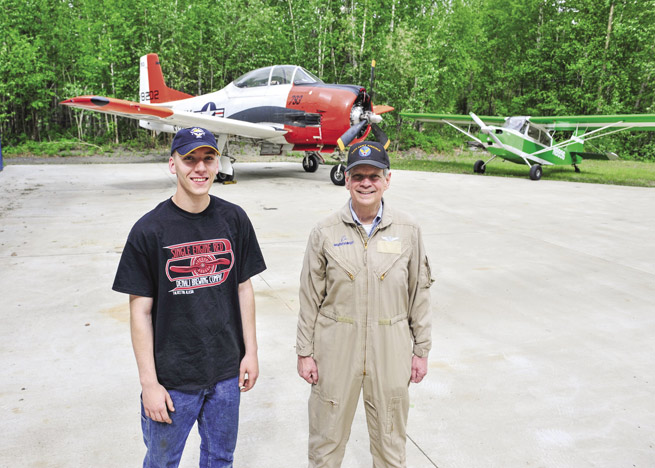
The pilots planned to depart Fairbanks in mid-July, with their exact route determined by weather, schedule, smoke from forest fires, and other logistical considerations. “The desired route will basically be backwards down the World War II Alaska-Siberia Route,” used to ferry military aircraft, Lee Gilbert said. “The air route was crucial to the outcome of World War II, and to be able to tie it to Wounded Warriors is incredible.”
Two pilots from Fairbanks, Alaska, are flying to EAA AirVenture in Oshkosh this summer, and they’ve decided to make the journey a fundraiser for the Wounded Warrior Project.
“I broke my first piggy bank in 1950 to take a ride in the backseat of an Aeronca Champ,” said Lee Gilbert, 68, a self-described “airplane nut” since age 4. He wanted to be an Air Force fighter pilot but flunked the flight physical. Instead, he served as an armorer, working with F–105s and F–4s in Thailand. Later he served as Civil Air Patrol liaison officer for the northern half of Alaska, and in the Air National Guard as a KC–135 crew chief. Now he does environmental work for the Army. Gilbert has never been to Oshkosh.
Alex Mumley-Dupuis, 21, earned his private certificate at age 18 while in high school. He enlisted in the Air Force and works in airport management. “My dreams are to become an aerobatic pilot, inspiring younger kids to take pursuit in aviation—much like the pilots who inspired me,” he said. He went to Oshkosh on an Air Academy scholarship from his EAA chapter in 1989, and flies Young Eagles frequently.
Gilbert said that he and his crew chief, Jeff Cornett, were determined to fly the T–28 to Oshkosh this year. “It’s been on our bucket list for a long time. Then Alex said, ‘Can I tag along in the Citabria?’ Then he came up with the idea for the Wounded Warrior Project.”
“With our background—both active-duty Air Force—we’re kind of embedded in that military brotherhood, and taking care of each other,” Mumley-Dupuis said. “I figured it would be a good opportunity to help in the betterment of others. Twenty years from now I want to look back and say, ‘We made a difference.’”
Mumley-Dupuis and coworker and roommate Brian Jones, who will accompany him, started raising money. “First we came up with $5,000 and Jones said, ‘I think we can do better,’” he said. They upped their goal to $10,000. “All contributions go to Wounded Warrior; all the expenses for the flight are coming out of our pockets.”
Email: [email protected]
First Look: They deliver
Reindeer sausage pizza anyone?
By Phil Scott
 Domino’s Pizza used to promise delivery in 30 minutes or less. Airport Pizza might take up to three hours, depending on the distance, the weather, and the number of stops before the bush pilot gets to the remote airstrip. Welcome to Nome, Alaska, population 3,000, where a 24-inch reindeer sausage pie costs between $50 and $60, and the pilot doesn’t expect a tip.
Domino’s Pizza used to promise delivery in 30 minutes or less. Airport Pizza might take up to three hours, depending on the distance, the weather, and the number of stops before the bush pilot gets to the remote airstrip. Welcome to Nome, Alaska, population 3,000, where a 24-inch reindeer sausage pie costs between $50 and $60, and the pilot doesn’t expect a tip.
“Up here it’s more just a general courtesy,” says Eric Greener, a 29-year-old, 5,500-hour bush pilot. Greener’s one of 150 pilots who fly for Ravn Alaska, the second largest Part 135 operator in the country, and an occasional pizza delivery man to tiny, remote villages sprinkling the wilderness outside Nome. “Pizza’s pretty unobtainable when you’re living out in the middle of nowhere.”
There’s not much in the way of weather reporting, minimal lighting on minimal strips measuring between 1,500 and 4,000 feet long covered with plenty of snow and ice in the winter, big mud pits when it melts, and dirt and gravel in the summer. “Some times of the year are better than others,” explains the laconic Greener.
Also, there’s never a terminal. “There’s basically a big parking lot,” he says. “We pull up and they come and grab it.” And that’s pretty much the airline’s involvement. Somebody calls up Airport Pizza, places an order, one of their folks throws it on the airplane—usually a Caravan with beefed-up gear and large tires. “In today’s day and age they pay over the phone,” he adds. “We’re not even handling cash.”
For Ravn Alaska’s trouble, Airport Pizza owner Bill Howell offers Ryan’s employees (along with Bering Air’s, another bush airline that delivers for Airport Pizza), half off their next pizza. He estimates that bush delivery amounts to 5 percent of the business. “We’ve got rock star pizza,” says Howell.
“It’s good—and the reindeer sausage pizza is great,” says Greener, who grew up near Chicago. “I wish they had deep dish, but I’m easygoing. If it’s edible I’ll take it.”
75 years ago this month
AOPA was founded May 15, 1939.
It is August 1939. The Chief Justice of the United States is Charles Evans Hughes. There are 48 stars on the American flag. Regular television broadcasts have begun in the United States. There is a drought in the northeast United States, causing a recession and soaring prices. Joseph Stalin is General Secretary of the Central Committee of the Soviet Union.
August 2
Albert Einstein alerts President Franklin D. Roosevelt to an A-bomb opportunity, which leads to the creation of the Manhattan Project. Einstein had arrived as a fugitive from Nazi Germany six years earlier.
August 6
First broadcast of the Dinah Shore Show on NBC radio.
August 15
The Wizard of Oz, MGM’s classic musical based on L. Frank Baum’s novel, and starring Judy Garland as Dorothy, premieres at Grauman’s Chinese Theater in Hollywood.
August 19
Adolf Hitler begins the opening operations for Fall Weiss, the invasion of Poland.
August 23
Hitler and Stalin sign the Molotov-Ribbentrop Pact, which stuns the world that the two countries have an alliance.
August 26
First major league baseball telecast—the Red Sox beat the Brooklyn Dodgers.
August 27
A Heinkel He 178, the first turbojet-powered aircraft, flies for the first time.
August 30
New York Yankee Atley Donald pitches a baseball at a record 94.7 mph.
Poland mobilizes against Nazi Germany.
Givng back: Saving puppies
And cats, and dogs
By Benét Wilson
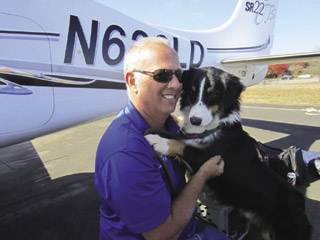 In September 2013, the AOPA Foundation gave away 10 grants, worth $10,000 each, as part of its Giving Back Program, designed to recognize good work being done through general aviation by nonprofit organizations. Pilots N Paws, which uses volunteer pilots to transport rescued, sheltered, or fostered animals, was one of those grant recipients.
In September 2013, the AOPA Foundation gave away 10 grants, worth $10,000 each, as part of its Giving Back Program, designed to recognize good work being done through general aviation by nonprofit organizations. Pilots N Paws, which uses volunteer pilots to transport rescued, sheltered, or fostered animals, was one of those grant recipients.
The organization heard about the program through word of mouth, said Pilots N Paws Executive Director Kathleen Quinn. “A lot of our pilots heard about the program and encouraged us to apply for it,” she said.
The $10,000 grant was used to help fund fly-away outreach events that resulted in hundreds of animals being rescued and delivered to new families along the East Coast. “When we started in 2009, we would do an annual event. But with the foundation grant, we can have two fly-aways,” said Quinn. “In October, we had 90 pilots working on one day to transport 535 animals, thanks to the AOPA Foundation.”
Pilots N Paws was able to empty an entire animal shelter, the Fort Stewart Military Pet Shelter, along with rescuing other animals in Hinesville, Georgia, near the base, said Quinn.
“A lot of animals went to New Jersey. Some pilots can do the entire flight, while some flew relay points to airports on the east coast, from Southern Pines, North Carolina, to points in Washington, D.C., and Virginia.
“One of the cool things about this fly-away was it was not just about the animals,” said Quinn. “While we’re dedicated to saving animals from shelters, we also impact the lives of the people we’re delivering animals to,” she said.
“Some of the animals came from Fort Stewart and they were sent to New Jersey to Paws of War and trained to become comfort and service animals for military members who have been affected by combat-related injuries and post-traumatic stress disorder.
“We also had a fly-away on March 1 out of Alabama, where we flew more than 200 animals,” said Quinn. “Our next fly-away will be September 26 to 27 at Greenville Downtown Airport in South Carolina, and we’re in the early stages of planning a Midwest fly-away.”
Email [email protected]
Details
The AOPA Foundation’s Giving Back Program awards grants to nonprofit groups doing good work through GA. The application process is open May until July.
Aerial adventures: Flying the Los Angeles area
Tips for out-of-towners
By Alton K. Marsh
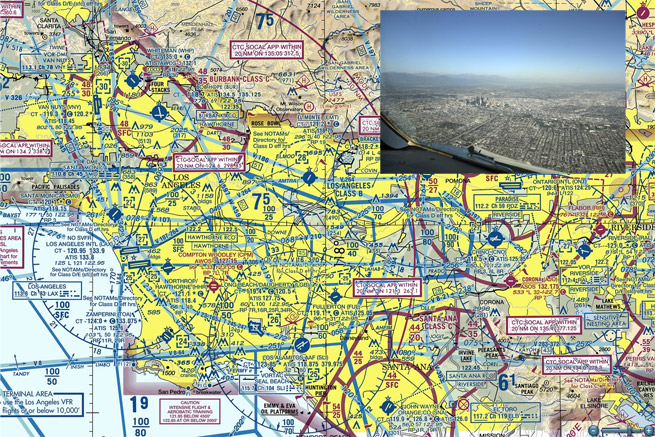
Pilots flying above Los Angeles are usually there to get from one place to another, not to impress friends with the scenery. Routes are defined by radials from VORs and must be rigidly followed, leaving little time for looking at anything other than conflicting traffic. Deviation just a few degrees from a radial creates potential for conflict with other traffic. Still, flying one of the routes across LAX can be spectacular.
If you have never done it, you might want to get training first from an instructor in the area. One of the best schools is Channel Islands Aviation of Camarillo, California, where chief instructor David Koble has some tips for you. Even if you memorized the route from the Los Angeles Terminal Area Chart, a marine layer of fog can suddenly create the need for an instrument approach or a quick escape to visual flight rules weather.
The routes depicted on the LA terminal area chart are the Coliseum Route, Hollywood Park Route, Coastal Route, and Mini Route. Koble suggests you avoid the Mini Route. Koble said both the northbound and southbound routes use 2,500 feet. That means a potential collision course, and at an altitude so low that an engine failure may create the necessity for an off-airport landing in commercial or residential areas. (Freeways are too busy to be considered.)
The best route, Koble said, is the Coastal Route with altitudes of 5,500 feet to 6,500 feet, depending on direction. It uses the 323- and 123-degree radials of the LAX VOR.
Email [email protected]
What you’ll see
The “Coastal Route” follows the shoreline and you’ll see the Santa Monica Pier, Marina Del Rey, and the Queen Mary.
Advice from a chief instructor
Chief instructor David Koble said a common mistake is to assume VFR checkpoints can be used to define the various routes. If you try to define the south end of the Hollywood Park Route using the Queen Mary (found in GPS databases as VPLQM), you’ll be two to three miles off the route.
If you use the Special Flight Rules route, controllers will not provide flight following. If you were already on it, they will cancel it. You’ll transmit position reports, either entering or exiting the route, to no one but other aircraft.
Contact clearance delivery at the departing airport and tell them your plan. In all likelihood that is what you will get. When taking off, tell the tower the route you plan to use.
After takeoff, advise departure control of your intended transition route through the Class B airspace. If controllers know ahead of time what you plan, they may clear you on course while still climbing from a lower altitude.
Study the map carefully to learn the location of the numerous flight training and aerobatic areas in the Los Angeles terminal area. They are marked on the chart and listed in the legend.
Pilot Products
Better safety, softer landings
KLR 10 AOA review
By Dave Hirschman
 Final approach speeds in most GA aircraft are a guessing game. The recommended speed is found in the pilot’s operating handbook, but that’s calculated at full gross weight. Then there’s the time-honored practice of noting the power-off, flaps-down stall speed (found at the bottom of the white arc on the airspeed indicator) and multiplying it by 1.3 to get a ballpark approach figure. And if the wind is gusty, add half the gust factor. As a result, our target speeds vary and tend to be based more on habit and intuition than hard numbers.
Final approach speeds in most GA aircraft are a guessing game. The recommended speed is found in the pilot’s operating handbook, but that’s calculated at full gross weight. Then there’s the time-honored practice of noting the power-off, flaps-down stall speed (found at the bottom of the white arc on the airspeed indicator) and multiplying it by 1.3 to get a ballpark approach figure. And if the wind is gusty, add half the gust factor. As a result, our target speeds vary and tend to be based more on habit and intuition than hard numbers.
Bendix King’s new KLR 10 Lift Reserve Indicator avoids the guesswork and helps pilots fly more precise approaches, accounting for variables such as payload and density altitude. Consistently better, and shorter, landings are among the benefits.
We recently installed the KLR 10 system in Editor in Chief Tom Haines’ Bonanza A36, an aircraft the staff uses for photography and company travel, and the KLR 10 light bar on the glareshield has quickly become indispensable. Up- and down-arrows are quick and easy to interpret, and the AOA indicator’s prominent placement means pilots don’t have to divide their attention between the airspeed indicator and the outside world.
During a series of flights in which the A36’s center of gravity ranged from full forward to nearly full aft, and loads varied from a single pilot and less than half fuel to four adults and full fuel, the AOA indicator provided a steady and accurate guide during approaches and landings. While flying the optimum AOA, the target final approach speed ranged from 81 mph when the airplane was light to 87 when fully loaded. Transitions during roundout and flare, however, felt nearly identical.
In the five years I’ve flown this particular A36, I’ve tended to approach too fast with the resulting few extra seconds floating in ground effect (and longer-than-necessary ground roll) as the obvious consequence. My rationalization was that slightly too fast is better than too slow, and since most GA airports have runways long enough to land an A36 two or three times—using that extra real estate hardly seemed like a tragedy.
But the KLR 10 will simplify future trips to short runways, and it allows pilots to keep their eyes outside throughout each approach and landing. As my confidence in the AOA indicator grew, the airspeed indicator became increasingly irrelevant. (The airspeed indicator lets you know when it’s safe to lower the gear and flaps.)
The technology’s real promise is reducing in-flight loss-of-control accidents in which airplanes inadvertently stall and spin. These often fatal accidents happen in airport traffic patterns when pilots get distracted and allow their airplanes to get too slow, turn too steeply, fly uncoordinated, or take other actions that raise the angle of attack to the “critical angle” at which the wing aerodynamically stalls.
The FAA’s Small Airplane Directorate has taken the forward-looking step of allowing aircraft owners and pilots to install a new generation of relatively low-cost, non-TSO angle of attack indicators with minimal paperwork. (The KLR 10 has a retail price of $1,600.)
It’s the avionics equivalent to adding seatbelt shoulder harnesses: It can’t hurt, and may help a lot.
Email [email protected]
Installing the KLR 10
The KLR 10 comes with all the required hardware, manuals, and even a small screwdriver to complete the installation and calibration. The probe is built to fit in an aluminum inspection hole cover. It’s exceptionally well manufactured, and completely independent from the aircraft pitot-static system.
Fitting the probe to an inspection plate in the Bonanza’s left wing, routing the associated plumbing into the fuselage, connecting the “interface module” under the left seat, and installing the AOA indicator took most of one day. Then it was time to calibrate the unit.
The calibration is a three-step process that requires smooth air—and that was in short supply this winter and spring on the East Coast. Our first few in-flight calibration attempts were unsuccessful and required altering the fixed angle of the probe. That meant filing out a groove in the inspection plate cover and repeating the process. The probe angle was reduced from 50 degrees to 45 and finally 40 before the calibration took hold. Once completed, it never has to be reset.
Also, for IFR airplanes, a heated AOA probe is highly desirable, since the tiny holes that sense differential pressure are susceptible to even trace amounts of airframe ice.
Flying with the AOA system brings home lessons that all pilots learn academically but don’t always understand intuitively: namely, that an airplane can stall at any airspeed and any attitude. In a steep turn, for example, AOA increases and can easily reach the critical angle at airspeeds far in excess of the power-off stall speed. Also, it’s possible to exceed the critical angle of attack even when pointed straight down, for example, on the back side of a loop. (Note to Tom: This is a purely theoretical discussion and I have not been looping your Bonanza!)
The AOA education and constant awareness that the KLR 10 and other indicators provide may ultimately be their most enduring safety legacy.—DMH
Birds, begone
Flock Buster repels with bad taste and smell
By Jill W. Tallman
Few things are more annoying than finding telltale signs that birds have moved into your hangar—or your airplane. And it’s not just the annoyance factor of cleaning up. Nesting materials in engine compartments can block airflow to cylinders or the oil cooler. You can put out rubber snakes and plastic owls and hope for the best, or you can try an environmentally friendly product used at airports, marinas, and parks.
Flock Buster’s recipe, which includes plant extracts and oils, is designed to repel birds through its taste and smell. You mix the solution with water and apply it with a hand or backpack sprayer to areas where birds nest, congregate, or feed. For a hangar, you may need a ladder or even a bucket lift to reach beams. For aircraft kept outside, you can apply it to the ground, or even directly to the airplane—it won’t harm paint. The manufacturer recommends that you avoid getting the product on static ports, windows and glare screens, and air vents.
I had noticed increased bird activity near my hangar this year, and discovered evidence that birds had taken up residence. I sprayed Flock Buster inside the hangar with a hand sprayer using a recommended 50:1 concentration, and reapplied a week later. The product seems to have had an effect: No new splotches, feathers, or other signs yet. The pigeons and starlings that brazenly fly into my hangar every time I open the door haven’t reappeared, either. I plan to continue applying Flock Buster throughout the fall and start up again in the spring—and with a two-year shelf life, Flock Buster will be ready when the birds return.
Flock Buster proved effective against large numbers of geese and seagulls when used in conjunction with harassment techniques at an airport in Devils Lake, North Dakota. Birds had been nesting and feeding within the approach zones to Devils Lake Regional Airport (DVL). Their numbers were reduced dramatically over a three-year period, to the point that there were so few geese in certain areas that airport personnel had begun to name them. Flock Buster is said to be effective on pigeons, starlings, crows, geese, swallows, blackbirds, woodpeckers, and other birds. Additionally, the formula includes a deer and rodent control additive.
Email [email protected]
Price: $23.50 (8 ounces)
Contact: www.flockbuster.com
Airport Stories: Up from the ashes
Valkaria find s the formula
By Bill Wilson
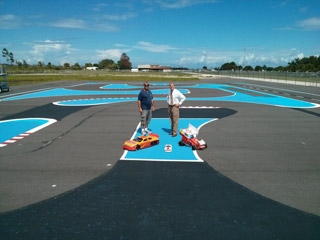 You would be forgiven if you wondered how an improbably named airport on the eastern shores of Florida would find the key to survival in a hostile environment—which might serve as a model for airports all over America. Valkaria Airport (X59), just south of Melbourne, has emerged from years of bitter controversy and not only prevailed, but is thriving. And, in so doing, it is providing other airports of similar fate with a formula for future success.
You would be forgiven if you wondered how an improbably named airport on the eastern shores of Florida would find the key to survival in a hostile environment—which might serve as a model for airports all over America. Valkaria Airport (X59), just south of Melbourne, has emerged from years of bitter controversy and not only prevailed, but is thriving. And, in so doing, it is providing other airports of similar fate with a formula for future success.
Born as a World War II Navy relief field with a triangular runway configuration, Valkaria was handed over to local authorities in the mid-1950s with the intent that it remain an airport. The goal was noble, but the execution lagged. Valkaria was subject to benign neglect for years and facilities suffered. Locals around the airport became restive when traffic picked up from a now defunct helicopter training school and began a drumbeat for closure. It accelerated to the point of dirty tricks, false accusations against airport employees, public arguments, and political interference. The local newspaper was actively searching out controversy and finding plenty. If there had been a Las Vegas line against Valkaria it would have been 100 to 1.
Enter Steve Borowski, new airport manager. Fortunately, Borowski knew how to fight fire with fire. He lined up his own political support, got money for a master plan, and saw it completed. The FAA, which had given over keys to the airport and did not really want them back, supported the effort with repairs, refurbishment, and guidance. With the active involvement of AOPA, the State of Florida, and the local Brevard County government, the nearby political opposition melted away and Valkaria was on its way to repairing its damaged past and emerging as a full-fledged general aviation/recreational airport.
Borowski knew that playing to only pilots would not win the public opinion lottery. So he worked out ways that surplus materials from the new runway, taxiway and other field improvements could be used to build facilities which could be used by the entire community. Today Skyman Park features a BMX bicycle course with jumps made from the coquina rock removed to build the new runway. In addition there is a radio-controlled car/truck/boat area that features not only a new pond and a smooth asphalt track for closed circuit races, but the largest off-road RC course in the country. The airport manager reports that bad blood which flowed so frequently from local political entities has almost vanished. Mutually beneficial communication channels are open and in regular use.
Borowski is sanguine about his success. “We’re up from the ashes, but we’ve only just begun.”
If you go
Valkaria Airport (X59)
Located one mile west of the city, X59 has two 4,000-foot runways with trees at each end. Be alert for model aircraft in the vicinity.
Tel. 321-952-4590
Hours: 8:30 a.m.-5 p.m.
Rental cars: Enterprise on field 321-728-7755 (www.aopa.org/cars) 866-315-9155
‘USA Today’ report overtly sensational; AOPA Responds
A USA Today series “Unfit for Flight” published in June presented a negative and highly distorted view of general aviation safety.
AOPA President Mark Baker responded with a letter to the editor pointing out that there has been a 75-percent decrease in fatalities from 1973 to today.
“General aviation—and AOPA—has been aggressive in pressing the FAA to make it easier and more affordable for new technology and safety equipment to be installed in the existing fleet,” Baker said.
The three-part series written by Tom Frank portrays GA as unsafe and investigations into GA accidents as flawed, incomplete, and favoring manufacturers. The reporter ignored information AOPA provided that showed new tools, training, and technology that make GA safer.
“USA Today’s snapshots of court cases and inflammatory headlines frankly do nothing to improve aviation safety. They only distort the true picture,” said Baker.
Go online for more.
Fly-outs: Priest Lake, Idaho
Two big airstrips—and a seaplane base
By Crista V. Worthy
Photo courtesy idaho division of aeronautics
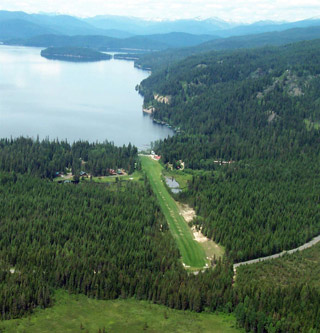 Priest Lake, the “Crown Jewel of Idaho,” is set against the western edge of Idaho’s Panhandle just 15 nautical miles south of the Canadian border and 54 nm northeast of Spokane, Washington. The sapphire-blue lake is surrounded by a dense emerald forest; mountains provide a scenic backdrop. Children play on white sand beaches or search for huckleberries as fishermen ply the lake for Dolly Varden, cutthroat, and Mackinaw trout and Kokanee salmon. The 57-1/2-pound U.S. record Mackinaw was caught here years ago—30-pound lunkers can still be pulled up with deeply trolled lures. Campers enjoy long summer evenings before curling up in their tents; other visitors splurge at lakeside resorts. Best of all, this pristine paradise is available to pilots with virtually any type of airplane—choose from two big airstrips and a seaplane base.
Priest Lake, the “Crown Jewel of Idaho,” is set against the western edge of Idaho’s Panhandle just 15 nautical miles south of the Canadian border and 54 nm northeast of Spokane, Washington. The sapphire-blue lake is surrounded by a dense emerald forest; mountains provide a scenic backdrop. Children play on white sand beaches or search for huckleberries as fishermen ply the lake for Dolly Varden, cutthroat, and Mackinaw trout and Kokanee salmon. The 57-1/2-pound U.S. record Mackinaw was caught here years ago—30-pound lunkers can still be pulled up with deeply trolled lures. Campers enjoy long summer evenings before curling up in their tents; other visitors splurge at lakeside resorts. Best of all, this pristine paradise is available to pilots with virtually any type of airplane—choose from two big airstrips and a seaplane base.
The Cavanaugh Bay Airport (66S) sits at the south end of Cavanaugh Bay, which extends like a thumb on the lake’s east side. Runway 15/33 is 3,100 feet of immaculate turf—a Citation III landed here last year. Approaches are normally made over the lake, right pattern to the uphill Runway 15. Watch for sprinklers which may be operating to one side; at 120 feet wide, there’s plenty of room. Parking and tiedowns are west of the runway. The shady campground is for fly-in guests only, with water, firewood, tables, hot showers, and a bunkhouse—all free. Friendly caretaker Allen Lieske, who has been here 14 summers, has hot coffee brewed by 5:30 a.m. and three courtesy cars that rent for $5 per day plus 30 cents a mile. The state park, seven miles away, has a wide beach and a store. You can rent boats, waverunners, kayaks, and canoes. On the lakeshore off the runway’s north end you’ll find Cavanaugh’s, with three condos, a cabin, and a restaurant/bar serving lunch, dinner, and Sunday brunch.
Dr. Loel Fenwick’s Tanglewood Seaplane Base (D28) welcomes visitors and is just 0.4 nm northwest of 66S and can accommodate even large seaplanes.
The Priest Lake USFS airstrip (67S), 1 nm west of the lake, is your best access to two upscale resorts. Runway 14/32 is 4,400 feet by 175 feet of dirt; use 122.9 for all area ops. Both resorts offer free pick-up and beaches for floatplanes. Hill’s Resort has a championship golf course, fine dining, water sports, and lake-or forest-view lodging. The Grandview Resort has a restaurant, cottages and suites with full kitcens, and watercraft for rent.
Crista Worthy is managing editor for Pilot Getaways magazine. She lives in Hidden Springs, Idaho.
If you go
Cavanaugh Bay Airstrip (D28) and Tanglewood Seaplane Base.
Located one mile northwest of the city.
Tel. 208-443-2589
Rental cars: (www.aopa.org/cars) 866-315-9155
Fly-outs made possible by Enterprise Rent-A-Car
Spokane Fly-in
AOPA’s fourth fly-in of 2014 takes place in nearby Spokane, Washington, August 16, from 8:30 a.m. until 4 p.m. at Felts Field (SFF). This historic airport was one of the first in the West. Aviation started here in 1910. Join AOPA at this storied airport for a fun fly-in day, which features expert speakers and seminars, great food, and family fun.
Laser-pointing perps
FBI offers $10,000 bounty
By Alyssa J. Miller
The FBI is offering up to a $10,000 reward for information leading to the arrest of people who intentionally point a laser at aircraft and is working to educate the public on the severity of such actions.
In 2012, shining a laser at an aircraft became a federal crime with a maximum punishment of five years in prison. In addition, such an act can be considered interfering with an aircraft, a felony carrying up to 20 years in prison and a fine up to $250,000. The FAA also can impose civil penalties.
Don’t get blinded by the light
A laser beam “can travel more than a mile and illuminate a cockpit” so brightly that it is the “equivalent of a camera flash going off in a pitch black car at night,” the FBI said. This can cause pilots to experience temporary blindness and lead to a safety-of-flight issue. Here are tips from the AOPA Foundation’s Air Safety Institute and FAA to protect yourself.
• Don’t look at the laser beam. “The natural reaction is to say, ‘Oh, look at that,’” said AOPA Foundation President Bruce Landsberg. “No, don’t do that.” Shield your eyes with your hand or a clipboard, if able.
• Don’t rub your eyes. Rubbing your eyes could cause further injury.
• Slide down in your seat. Lower yourself in the cockpit to prevent being hit directly.
• Turn up the lights in the cockpit. This helps to minimize the effects of sudden bright lights at night.
• Look at your flight instruments. The sudden flash of the laser is similar to flying into instrument conditions. Focus on your instruments and don’t make sudden movements.
• Use all available resources to maintain aircraft control. Turn on the autopilot to maintain a stabilized flight path while your eyesight recovers.
• If more than one pilot is on board, transfer control of the aircraft to the pilot who is least impacted by the laser.
• Communicate the incident to ATC. Notify air traffic controllers who can, in turn, warn others of the potential hazard.
• Use the aircraft. Climb or turn away from the laser to use the aircraft to block its beam.
Email a[email protected]
World’s only civilian tiltrotor
AgustaWestland completes autorotation tests
By Ian J. Twombly
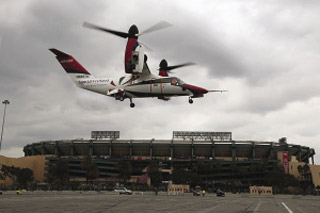 AgustaWestland announced recently that its AW609 Tiltrotor has completed dual-engine-failure autorotation tests. This is a big milestone in the long development process that will result in the world’s only civilian tiltrotor, expected to be certified in 2017.
AgustaWestland announced recently that its AW609 Tiltrotor has completed dual-engine-failure autorotation tests. This is a big milestone in the long development process that will result in the world’s only civilian tiltrotor, expected to be certified in 2017.
The aircraft’s massive prop rotors make it impossible to land and take off with the engines in airplane mode. Because the aircraft exists in the space somewhere between an airplane and a helicopter, AW had to work with the FAA to determine exactly how it would be tested. The result was a requirement to be able to land safely in the same way a helicopter does after a failure in either mode. For the testing program, that meant a demonstrated ability to go from a worst-case scenario of full aircraft mode to a safe landing in full helicopter mode.
The few people outside company test pilots who have flown the aircraft praise its automated systems management capability. That is on display during the autorotation, where the aircraft automatically maintains an angle of incidence that results in 100 percent rpm after an engine or drive system failure. As the aircraft descends it must at some point convert fully to helicopter mode, which the company said it does rapidly. The nacelles go to a full aft position of 95 degrees for a run-on landing.
Most interesting about the aircraft is what might lead to a failure. It’s powered by Pratt & Whitney PT6 engines, each with its own gearbox. Both are connected by a common drive shaft, so if one engine fails, the other working engine will provide power to both rotors.
AW thinks a complete and simultaneous dual failure is highly improbable, and the only time it envisions a subsequent failure is with fuel contamination. Either way, more than 70 tests over 10 flight hours appear to prove the aircraft has the ability to handle such a problem.
Email [email protected]
Honoring the heroes
Doolittle Raiders receive Congressional Gold Medal
By Alyssa J. Miller
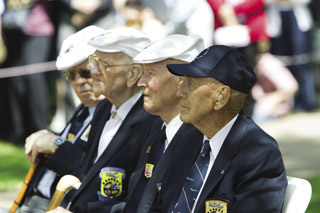 Seventy-two years after successfully bombing Japan, changing the course of World War II in the Pacific, the Doolittle Tokyo Raiders have been honored with a Congressional Gold Medal.
Seventy-two years after successfully bombing Japan, changing the course of World War II in the Pacific, the Doolittle Tokyo Raiders have been honored with a Congressional Gold Medal.
The medal was accepted on behalf of the group by Lt. Col. Richard E. Cole, and will be given to the National Museum of the U.S. Air Force and displayed with the Raiders’ goblets.
Only four of the 80 Raiders are living today: Cole, Lt. Col. Edward J. Saylor, Staff Sgt. David G. Thatcher, and Lt. Col. Robert L. Hite.
On April 18, 1942, the Raiders, led by James H. “Jimmy” Doolittle, flew 16 B–25Bs from the USS Hornet in the Pacific Ocean to bomb Tokyo. The group overcame many obstacles to complete the risky mission—flying bombers off an aircraft carrier, taking off farther out to sea than planned after being spotted by the enemy, and facing deteriorating weather conditions en route, especially nearing China. After bombing their targets in Japan, one crew landed in the Soviet Union; the others bailed out over China or ditched off the Chinese coast (see “Secret Mission,” October 2012 AOPA Pilot).
Four of the raiders Lt. Col. Edward J. Saylor, the late Maj. Thomas C. Griffin, Staff Sgt. David G. Thatcher, and Lt. Col. Richard E. Cole (top). The USS Hornet in 1941 (above).
Email [email protected]
Flying Clubs: Club appeal
Flight training with a flying club
By Benét J. Wilson
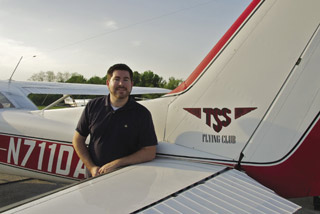 Phil Wessell is an architect in the Washington, D.C., area. He joined the TSS Flying Club at the Montgomery County Airpark (GAI) in Gaithersburg, Maryland, in August 2013 specifically to start flight training toward his private pilot certificate.
Phil Wessell is an architect in the Washington, D.C., area. He joined the TSS Flying Club at the Montgomery County Airpark (GAI) in Gaithersburg, Maryland, in August 2013 specifically to start flight training toward his private pilot certificate.
Wessell, an AOPA member since 2011, recalls his eighth grade history teacher gave him a stack of old issues of AOPA Pilot magazine. “I think I read those magazines cover to cover over the summer while pestering my parents, unsuccessfully, to let me take flying lessons,” he said.
The TSS Flying Club appealed to Wessell because of the benefits it offers to someone starting flight training. “Joining a club connected me with a community of other pilots and instructors with a wide variety of flying experience. I’m not sure you’d get the same social experience through a flight school,” he said.
Cost was another big factor, he said. “The club charges for aircraft use based on tach time instead of Hobbs time,” he said. “The club rates for a Cessna 172 are $129 per tach hour wet, which is already significantly below the cost at several of the local flight schools.”
Wessell calculates he has already saved about $800 in his first 20 hours of flying when compared to what his expenses would have been at one of the local flight schools.
Wessell offered advice for those considering a path similar to his. “Make sure you do your research. In addition to running the numbers to make sure the club makes financial sense, spend some time talking to club members and going to a few club meetings to make sure the atmosphere is what you’re looking for,” he said. “Not all clubs are created equal. As long as you go into it with realistic expectations, a flying club can be a great way to earn your certificate.”
Email [email protected]
Want to know more?
AOPA’s Guide to Starting a Flying Club is a helpful new tool that steers members through the critical steps of starting a club.
Pilot, wife retrace ‘Flight of Passage’ journey
Same Cub that author, brother flew 48 years ago
By Mike Collins
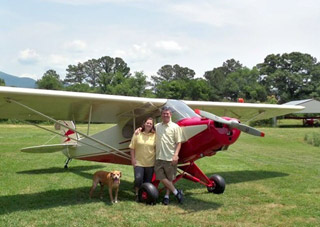 Chris Nesin and his wife, April, flew across the United States in a restored Piper Cub during late June and early July. What made their journey unique is that the 1949 Piper PA–11 is the same airplane that was flown across the country in 1966 by teenagers Kern and Rinker Buck. Later, Rinker Buck penned the book Flight of Passage, a memoir based on their trip.
Chris Nesin and his wife, April, flew across the United States in a restored Piper Cub during late June and early July. What made their journey unique is that the 1949 Piper PA–11 is the same airplane that was flown across the country in 1966 by teenagers Kern and Rinker Buck. Later, Rinker Buck penned the book Flight of Passage, a memoir based on their trip.
So 48 years later, the Nesins flew N4971H from the East Coast to the West Coast, retracing the Bucks’ route. After a visit to the Sentimental Journey Fly-In in Lock Haven, Pennsylvania, they flew 180 nautical miles east-northeast to Candlelight Farms Airport in New Milford, Connecticut—where they met, and flew with, both of the Bucks. “There was lots of flying, both literal and hangar,” Chris Nesin said. “[And] both of the Buck brothers were impressed with the rebuild—and how it flew.”
Rinker Buck doesn’t consider Flight of Passage an aviation book. “I consider it a memoir in the truer sense. It’s about life,” he said in an August 2013 article in Flight Training.
The Nesins’ journey also helped raise awareness for the Austin Hatcher Foundation for Pediatric Cancer (www.hatcherfoundation.org), an organization working to restore the spirit of children and families dealing with the effects of pediatric cancer. April Nesin works there as a clinical psychologist. Chris, who learned to fly in college, works as a Cessna Citation Sovereign pilot.
They traced the Bucks’ route as closely as they could. However, they did not replicate that five-day schedule. “They actually did it in four days—they spent an extra day in El Paso,” Nesin said. “They flew eight hours a day, but they were also 15 and 17.” He flew the Cub a solid six hours to Lock Haven, and “that was about three hours too much,” he laughed. They planned to fly three to four hours per day, about 250 miles. “That actually gets us there in eight days, but I’m planning to stop for weather a couple of days.”
One difference between this trip and the Bucks’ 48 years ago is the need for a communications radio. “Safety-wise, we were taught to use the radio more than they were,” Nesin observed. “Personally I like the ability to go into a towered airport, so I keep a handheld radio and an antenna.” He said the Bucks flew into the tower-controlled El Paso airport using light-gun signals. “I don’t think they flew into any other airports that were towered then.”
Chris bought his first Cub in 2000. “I got hooked on them with a friend who gave me the book Flight of Passage,” he said. “I looked at going to the West Coast, but the 65-horse [engine] wouldn’t do it.” He started looking for another airplane in the spring of 2011 and that October, he received an email that the Flight of Passage airplane was for sale. He called to find someone from Michigan had bought the airplane—and two other Cubs. But that buyer backed out and Nesin was able to purchase N4971H.
Restoration took two and a half years. “So many people have come out to help on this project, because they wanted to be involved,” he said—generosity that helped to lower his cost for the restoration. The Nesins did a lot of the cleaning. “We saved almost all of the wing parts, but it was a lot of work. It may just be the romantic in me, but I felt like I was losing history every time I replaced a part.” Some key parts were replaced; for example, he upgraded to new Univair wing struts.
Chris’ “wonderful, crazy 73-year-old mother” drove a camper along the route. She carried bags and their dog Lenny, who loves to fly. His mom is “the unsung hero,” Chris said.
See photos, videos, and a trip blog online.
Email [email protected]
‘Dragon Lady’ stops traffic
FAA says computer problem identified, resolved
By Jim Moore
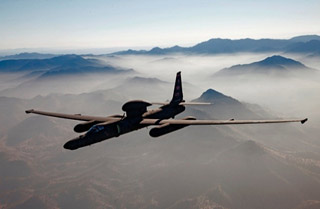 She may be pushing 60, but the “Dragon Lady” can still stop traffic. The FAA’s new air traffic control computers forced a temporary ground stop that affected thousands of travel plans last spring.
She may be pushing 60, but the “Dragon Lady” can still stop traffic. The FAA’s new air traffic control computers forced a temporary ground stop that affected thousands of travel plans last spring.
A U–2 flight plan caused the software glitch that affected air traffic in, and into, Southern California and Nevada, forcing a ground stop that affected flights around the country. The trouble was the most publicly visible snafu for a new system that has been set back by cost overruns and delays. The En Route Automation Modernization (ERAM) computer system, contracted originally at $2.1 billion, is a major upgrade to the FAA’s 40-year-old routing system—and a critical component of the NextGen airspace modernization program.
Ironically, Lockheed Martin is both the primary contractor building the new computer system and the builder of the U–2. The U–2 first flew in 1955 and remains in service with the U.S. Air Force and NASA, which operates a civilian variant known as the ER–2. The U–2 is capable of flying above 70,000 feet (the actual service ceiling remains classified), and the April 30 flight plan was filed for 60,000 feet, well above the crowded air routes. The computer system interpreted the mission as a VFR flight with an altitude below 10,000 feet.
The Los Angeles Air Route Traffic Control Center computer system went down for nearly an hour, and halted flights in the region, along with flights destined for Southern California and Las Vegas. More than two dozen flights were canceled, more than 200 were delayed, and thousands of passengers were affected, along with an unknown number of general aviation flights.
Email [email protected]
GA in China
Quicksilver signs Chinese distributor
By Alton K. Marsh
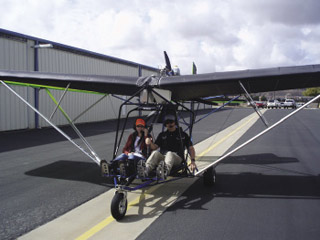 Yet another American aviation firm has struck a deal with a Chinese company. Quicksilver Aeronautics says it has a distribution agreement resulting in an order for 77 Light Sport aircraft. The first two aircraft were completed at Quicksilver’s Temecula, California, factory and will be shipped to China for final assembly, testing, and training of Chinese technicians.
Yet another American aviation firm has struck a deal with a Chinese company. Quicksilver Aeronautics says it has a distribution agreement resulting in an order for 77 Light Sport aircraft. The first two aircraft were completed at Quicksilver’s Temecula, California, factory and will be shipped to China for final assembly, testing, and training of Chinese technicians.
The order includes 30 Sport 2SE models and 47 GT 500 models.
The deal was signed with the JH Nanning Group and the Provincial Government of Guangxi, on the border with Vietnam, for the development of GA in southern China. As part of the distribution agreement, JH Nanning Group is the exclusive distributor of Quicksilver in China. Negotiations were with Liang Ming, president and CEO of Guangxi Jihang General Aviation Company, and Quicksilver Aeronautics President and CEO Will Escutia.
There are plans to consider manufacturing aircraft components in China and to do research and development at a new China Aeronautical University under construction.
Quicksilver joins a growing list of American companies with connections to the People’s Republic of China. Successful collaborations include Cirrus Aircraft and Continental Motors, although deals with Sherpa Aircraft and Liberty Aircraft failed. Zenith Aircraft has shipped 45 kits to China.
Email [email protected]
THIS MONTH ON THE AOPA JAY
EAA AirVenture Oshkosh Fisk VFR arrival
Flying to AirVenture in Oshkosh is a bucket-list item for many pilots. Whether you want to practice for the real thing, or just try the arrival out for yourself, you can—even before the show—on your AOPA Jay.
You’ll fly the Fisk VFR Arrival in a Cessna 172 with EAA’s Hal Bryan in the right seat. He’ll handle the radios, and help you out as you make your way to OSH.
The flight starts in the air, seven miles south of Ripon, headed north at 1,800 feet. You’ll fly over photorealistic scenery provided by MegaSceneryEarth, and join the arrival at Ripon. Listen for the controllers at Fisk and follow their instructions. You’ll be expected to land on the assigned runway on the assigned dot—just like the pilots flying into Oshkosh this year for real.
Extra: Don’t have your AOPA Jay yet? Find out more online.
Civil Air Patrol wins Congressional Gold Medal
The Civil Air Patrol has received a Congressional Gold Medal one year after it was first approved by the Senate. Sen. Tom Harkin (D-Iowa) introduced the legislation in February 2013.
The CAP was founded December 1, 1941, a week before the bombing of Pearl Harbor. Within three months, CAP members were using their own airplanes to fly anti-submarine missions off the East and Gulf coasts, where German U-boats were sinking American ships carrying oil and other vital supplies to the Allies.
By the time that mission ended August 31, 1943, CAP’s coastal patrols had flown 86,685 missions totaling 244,600 hours. Seventy-four airplanes sent out from coastal patrol bases crashed into the water; 26 CAP members were killed.
Swearingen heads west
Renowned aircraft designer and engineer left lasting mark
By Jim Moore
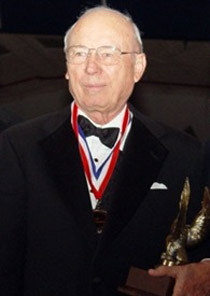 Edward Swearingen began dreaming about airplanes as a boy, and displayed an early genius as a mechanic and engineer, largely self-taught. He adapted Bill Lear’s groundbreaking F-5 autopilot for general aviation piston aircraft—among many design contributions to GA aircraft from major manufacturers—and went on to design 30 original aircraft. His thirty-first design was on the drawing board when Swearingen died May 15 at age 88, following complications from surgery.
Edward Swearingen began dreaming about airplanes as a boy, and displayed an early genius as a mechanic and engineer, largely self-taught. He adapted Bill Lear’s groundbreaking F-5 autopilot for general aviation piston aircraft—among many design contributions to GA aircraft from major manufacturers—and went on to design 30 original aircraft. His thirty-first design was on the drawing board when Swearingen died May 15 at age 88, following complications from surgery.
Swearingen launched his first company, Swearingen Aviation, in 1958, and quickly attracted a list of clients including Piper Aircraft Co., Bell Helicopter, Lycoming, and Pratt & Whitney, earning an international reputation as a go-to designer for innovative modifications and development.
Swearingen’s own designs ranged from commercial airliners (including the Metroliner) to business jets. He sold a 90-percent share of his first company to Fairchild in 1972, and continued to serve as chairman of the board of the resulting subsidiary; in 1973 he founded a new firm to focus on aircraft modification; in 1986, he formed Swearingen Engineering and Technology to market a groundbreaking business jet design, the SJ30.
That design lives on and a new company aims to bring it to market. The SJ30, Swearingen’s final completed design, offers performance that remains competitive with modern aircraft.
“The success of the SJ30 was all about getting the best possible balance of the wing shape, engines, aerodynamics, and overall design. Our performance isn’t magic; it is simple, well-applied technology,” he said.
Email [email protected]
Mini-me plane nears Light Sport certification
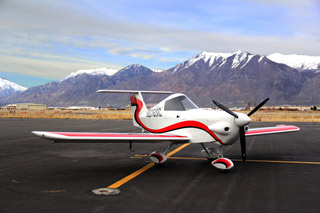 Airplanes cost too much, most of us agree, so here is one that fits the original promise of a $60,000 Light Sport aircraft. The Czech-designed Skycraft SD-1 Minisport costs $54,850 ready to fly. All flight testing is complete and the FAA was expected to work it into its approval schedule as early as July.
Airplanes cost too much, most of us agree, so here is one that fits the original promise of a $60,000 Light Sport aircraft. The Czech-designed Skycraft SD-1 Minisport costs $54,850 ready to fly. All flight testing is complete and the FAA was expected to work it into its approval schedule as early as July.
Four have been ordered and a dozen are in production at the Orem, Utah, factory 40 minutes south of Salt Lake City. Charts showing the range of the tiny aircraft, with a 20-foot wingspan, indicate you could take off from Chicago and make it to anywhere in Kentucky, or leave New York and reach southern Virginia, or depart Los Angeles and arrive in Las Vegas with a comfortable fuel reserve.
There’s only room for one person, so Skycraft officials are busy choosing a two-seat trainer of another model that most closely approximates the handling qualities of the Minisport. Also, that one person can’t weigh more than 230 pounds, another reason to stay on that diet you ignore and activate the exercise plan that never quite got going. You can carry 23 pounds of baggage. The cabin is 20 inches wide and wings are removable. A 50-horsepower Hirth engine powers this 96-knot aircraft, which is limited to a 10-knot crosswind. —Alton K. Marsh
The DA62
Diamond ‘rebrands’ top-of-the-line twin
By Alton K. Marsh
Earlier this year Austrian-based Diamond Aircraft officials said they were headed for “preliminary” certification of the DA52, their top-of-the-line light twin, by the end of 2014 with full certification in 2015. However, when it is finally certified the name will be the DA62, rather than the DA52. A company official said it has been rebranded with the new model name to give it separation from the four-place DA42. Aircraft company officials want the five-place model to be seen as competition for the Beechcraft Baron. Sometime in the future the DA62 might be expanded to a six- or seven-seat aircraft, Diamond officials in Canada said. (The DA62 is in development in Austria.)
Certification in Europe is not expected until the first quarter of 2015, with FAA certification to follow under an international agreement.
It isn’t the exact same model. Aerodynamic tweaking has allowed the airspeed claim to be increased from 190 knots true airspeed to 200 knots true airspeed. Part of that tweaking includes, according to a photo released by the company, a salmon-shaped tube in the center of the T-tail’s horizontal stabilizer. It will still be equipped with 168-horsepower Austro AE300 diesel-fueled engines, modified to produce 180 horsepower—as was the case with the DA52. The company is in joint development of a 280-horsepower AE500 diesel engine. The Austro-Steyr AE500 is based on an automotive and marine engine designed by Steyr Motors, also located in Austria. That engine will require time to develop and won’t be offered on the DA62.
Dealers in the United States were caught off-guard by the change in model number, one saying he was as surprised as the general public.
Email [email protected]
Colorado pilot earns spot in French air race
A pilot from Colorado who speaks three languages and recently became a flight instructor will soon be on her way to France to fly in the Tour Aérien Des Jeunes Pilotes, her expenses paid by the International Council of Aircraft Owner and Pilot Associations (IAOPA).
Kayla Graham, 23, of Centennial, Colorado, was selected from a pool of 34 qualified applicants by AOPA, IAOPA, and the Fédération Française Aéronautique. The organizations had sought applications from American pilots interested in flying in the 2014 race. Graham’s roundtrip airfare to France, airplane rental for the race, and other expenses will be covered. She will fly with an English-speaking French flight instructor.Forty pilots between ages 18 and 24 will take part in the Tour Aérien Des Jeunes Pilotes July 19 to August 3. The event, in its fifty-seventh year, seeks to inspire the next generation of pilots and promote general aviation in France. Representatives of the Fédération Française Aéronautique visited AOPA in May 2013 to discuss the history of the race, which is made possible by volunteers, experienced pilots, and flying clubs.
Graham works for Jeppesen, maintaining terminal approach charts (in the Australia quadrant), A language major in college, Graham has conversational command of French and Spanish. As “a language nerd before I ever got into aviation,” she sees the trip as a rare opportunity to combine her twin passions for linguistics and aviation in a single activity.
In May she earned her flight instructor’s certificate and joined the instructors’ ranks of the Aspen Flying Club flying from Centennial Airport in Englewood, and Front Range Airport in Denver.
“It is the proudest I have felt yet with my flight accomplishments,” she said of becoming a CFI. “I really love instructing.” —Dan Namowitz
Electric power
An auspicious time for quiet aircraft
By Jim Moore
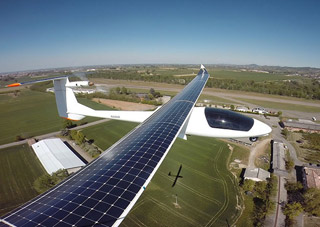 With the pioneer age of electric aircraft now well under way, attention has turned to practical applications.
With the pioneer age of electric aircraft now well under way, attention has turned to practical applications.
Solar Flight is testing the Sunseeker Duo, a two-seater powered by the sun. It was flown by Eric Raymond, who has been working on solar aircraft for 25 years with his wife, Irena Raymond.
In Bordeaux, France, Airbus Group (the new name for Airbus parent EADS, pending final approval of the change) is also testing an electric aircraft. The E-Fan has motors, two seats, and runs entirely on batteries, testing concepts that will pave the way for short-haul airliners able to run on swappable batteries that can be changed out at the gate in about as much time as it takes to unload luggage. Advanced materials and systems also power Solar Impulse 2, the around-the-world successor to Solar Impulse, which captured attention on a high-profile mission across the United States in 2013.
CAFE Foundation President Brien Seeley said in Santa Rosa, California, his organization hopes to replicate its 2011 Green Flight Challenge in the near future, leveraging another cash prize (or prizes) to stimulate a fresh wave of electric aircraft development. Seeley said the CAFE Foundation founders did not imagine that electric aircraft would fly so far, so soon.
“It’s been fortuitous to be riding this tsunami,” Seeley said.
For now, the endurance limit remains around an hour for various light aircraft designs currently flying on battery power. The Sunseeker Duo can cruise up to 12 hours with two people on board, the Raymonds announced, relying on a combination of 1,510 solar cells and batteries that boast 23-percent efficiency for power.
“The lithium batteries today have seven times more capacity than the nickel cadmium batteries we used in Sunseeker I,” Eric Raymond said in a press release. “When we first sketched the concept for this airplane, we couldn’t imagine solar cells with greater than 20-percent efficiency. These technologies are a dream comes true.”
Email [email protected]
Second launch
Swearingen design gets update
By Jim Moore
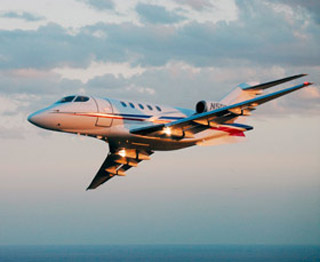 The elusive SyberJet SJ30, a sleek, fast, high-flying light jet with long range and distinctively bowlegged mains, may soon make believers of those made skeptical by the two-decade wait. Only four have ever been sold, one to actor Morgan Freeman, who joined SyberJet Aircraft officials in May for a groundbreaking ceremony in Cedar City, Utah, where a completion and delivery center—the first phase of a factory master plan—is scheduled to be online by year’s end.
The elusive SyberJet SJ30, a sleek, fast, high-flying light jet with long range and distinctively bowlegged mains, may soon make believers of those made skeptical by the two-decade wait. Only four have ever been sold, one to actor Morgan Freeman, who joined SyberJet Aircraft officials in May for a groundbreaking ceremony in Cedar City, Utah, where a completion and delivery center—the first phase of a factory master plan—is scheduled to be online by year’s end.
Freeman will be the launch customer (or re-launch customer, arguably) for an updated version of the SJ30 being prepared for certification of significant updates to the design that Freeman purchased in 2009. Deliveries of the SJ30i, equipped with Honeywell-designed SyberVision avionics—including synthetic vision and other modern features—and a new interior, are expected in 2015 with an engine update to follow in 2017.
Those stand to be milestones in an aircraft history that stands out for long endurance in the absence of significant success.
The SJ30—previously known as the SA–30, the Gulfstream Gulfjet (Gulfstream’s involvement ended in 1989), the SJ–30 and the SJ30–2—was conceived by the late Ed Swearingen (see page 60), and was rolled out at the 1991 Paris Air Show. It remained in the prototype stage for the remainder of the decade, and suffered the loss of test pilot Carroll Beeler in 2003. The NTSB determined in 2005 that the probable cause was the manufacturer’s incomplete research on high-speed stability. Changes had been made, and in October 2005, the office of Sen. Jay Rockefeller (D-W.Va.) celebrated FAA certification of the “first new American corporate jet manufactured and designed from scratch in 45 years.”
The type certificate and other assets that became SyberJet Aircraft were purchased out of bankruptcy in 2011 by MSC Aerospace, a company created for the purpose by Metalcraft Technologies, which has supplied the majority of the SJ30’s parts and assemblies since 1997.
Mark Fairchild, general manager of SyberJet Aircraft, declined to name a price for the updated design, which retains the 2,500-nautical mile range, seating for seven (including the pilot), and 12-psi cabin pressurization system able to maintain sea-level pressure up to 41,000 feet. The SJ30 can cruise at Mach 0.83 (486 knots), throttling back to Mach 0.76 to reach its range potential. Media coverage of the National Business Aviation Association convention in 2013 included a fresh wave of SJ30 anticipation, with an expected price tag of the updated model reported at $7.25 million.
Email [email protected]
Set a reminder
As a part of its year-long fly-in schedule, AOPA is again hosting visitors at its Frederick, Maryland, headquarters October 4, 2014. AOPA’s “Homecoming” Fly-In will feature all of the events that are taking place at regional fly-ins this summer—seminars, guest speakers, aircraft displays, great food, and family fun.
For more information on Frederick’s Homecoming fly-in and all of this summer’s regional fly-ins, visit the website.



